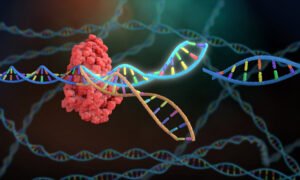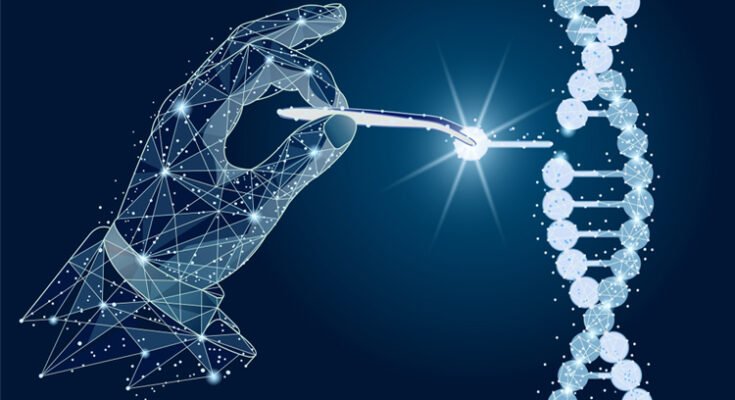CRISPR has already revolutionized the world of biotechnology, but now gene editing tools like CEISPR have been combined with Artificial Intelligence, which has improved the technique and its accelerating advances in medicine, agriculture, and synthetic biology that were not possible before. It has unlocked the potential to create faster, safer, and better artificial life to treat powerful genetic diseases and increase crop yields and more.
What Is CRISPR?
- (Clustered Regularly Inerspaced Short Palindromic Repeats) This is a gene editing technology that allows scientists to cut, remove, replace, and change specific parts of the DNA. It is thought of as a genetic “Sassors” (like the enzyme Cas-9). But it is a challenge that gene editing must be extremely precise, otherwise a small mistake can cause a dangerous mutation and other unintended effects.
- These are segments of DNA found in Bacteria and archaea that act as the bacteria’s immune system. They store fragments of viral DNA that allow the bacteria to recognize future infections and develop resistance against them.
Role of AI in CRISPR.
Artificial Intelligence helps in CRISPR for better work. AI is designed to read more than a million DNA sequences it tells us the best target sites in the genome. AI reduces the chance of error, which improves the design of guide DNA. It informs us about all the results and problems before doing real experiments.
1. Target Site Prediction.
Target site detection is one of the most important steps in CRISPR gene editing. It involves finding the right location in the DNA where the CRISPR system is to cut, and identifying the right place to ensure that gene editing is done accurately and safely, especially when treating diseases or crops that should be modified, and finding better target sites is very complex. The human genome has more than 3 billion base pairs, and a small change can have big consequences. This is where artificial intelligence plays an important role.
How AI Enhances Target Sites Prediction?
1. Analyzing Massive DNA Data: It can process large amounts of genetic data and has been successful (or failed) in different species and cell types. It predicts which sites of DNA are likely to yield the correct result.
2. Scoring Potential Targets: The AI model assigns a score to potential CRISPR target sites based on.
- Specificity ( what is the percentage chance that it will cut the desired spot)
- Efficiency ( how will it cut)
- Risk off-target edits ( unwanted mutation)
3. Personalized Targeting: AI in medical gene therapy helps predict targets based on an individual’s genome, which means CRISPR editing can be personalized for each patient’s DNA. Examples:
- Deep CRISPR
- CRISPR Scan
- sgRNA Designer
2. Guide RNA Design.
- CRISPR uses short RNA sequences ( guide RNA or gRNA) to cut a section of DNA.
- AI reduces the risk of cutting the section in the wrong place ( off-target effect ).
- AI helps in boosting the precision and binding strength of guide RNA.

3. Off-Target Risk Minimization.
- CRISPR uses guide RNA to find the short target sites of the DNA. But sometimes this guide RNA mistakenly binds to another site. This results in off-target cuts that cause mutations in important genes, and makes the treatments unsafe for medical use.
- The biggest challenge in CRISPR gene editing is off-target effects. When the CRISPR system cuts DNA at an unintended location, it causes a change in the genome, creating a harmful mutation or healthy genome is disrupted or the treatment causes dangerous side effects. To make gene editing safer, scientists have incorporated artificial intelligence into a powerful role to reduce off-target risk, so that gene editing can be done safely.
4. Predicting Gene Function and Mutation Impact.
- AI detects DNA patterns to predict how a specific change would affect a person’s health if it were to occur. to estimate which genes are the right ones to edit. AI does this job well and is less likely to make mistakes.
- AI tells us all the ways genes work, what good effects they will have, what bad effects they will have, and what mistakes can be made. AI tells us all these things better than humans. AI informs us in advance about the effects of mutation and the changes that result from mutation.

5. Accelerating Research.
- The biggest challenge involved in biotechnology is the time and cost involved in research. Scientists develop a test model of CRISPR before implementing it, which can take weeks to months to develop. But Artificial Intelligence can do this work much faster and with less chance of error. AI can quickly prepare the prototype of gene editing, which leads to lower costs and accurate results in discoveries.
Results.
Artificial Intelligence has proven to be helpful in every way in CRISPR and gene editing; it has made it easier to do all the work in every place where there is a high chance of making mistakes. AI is helping us in every way, be it in the medical field, be it about crops, be it about research anything else, it is proving to be better for us in every way.
